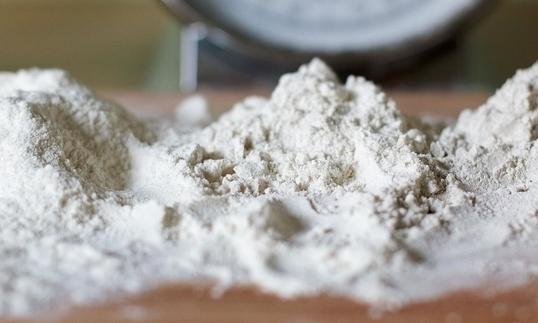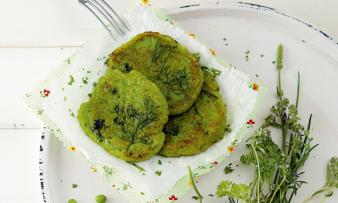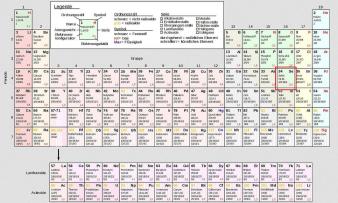Table of contents
By grinding wheat grains, you get wheat flour ( raw, organic), which is used in a variety of baked goods. Wheat is known as a bread grain because the high gluten content ensures an elastic dough that rises well in the oven.
Use in the kitchen
The neutral-tasting wheat flour (vegan) is considered a staple food because it is very inexpensive and has many uses. Wheat flour is not suitable as a raw food because it can contain germs that can lead to stomach pain and diarrhea.
What is wheat flour?
- White flour (corresponds to German wheat flour types 405 and 550): White flour made from wheat is a light flour with a high gluten content, which is crucial for its good baking properties. It contains little to no husk and germ and consists mainly of the starchy endosperm. It is ideal for baked goods such as cakes, biscuits, tarts, light breads, pizza, baguettes and for thickening soups or sauces. The light wheat flour can also be used to make the vegan meat substitute seitan.
- Semi-white flour (Germany: Type 812): This contains more hulls and therefore more nutrients. This makes the wheat flour suitable for light or mixed breads.
- Ruchmehl (Germany: Type 1050 and 1200): Ruchmehl made from wheat has a much more pronounced wheat flavor, is darker and nutritious due to the minerals, proteins and vitamins it contains. The flour is used to make dark baked goods and breads with a crispy crumb.
- Wholemeal flour : Wholemeal flour made from wheat contains at least 98% of the wheat grain. It is rich in nutrients and filling because it contains the husks, the aleurone layer and the germ of the wheat grain. Wholemeal flour is used for wholemeal bread or healthy biscuits. 1
Homemade preparation
Fresh, home-ground wheat flour (vegan) contains more nutrients than store-bought flour, no additives and is therefore healthier. Home-ground flour is always wholemeal flour, because the whole grain is used when grinding. Since the finished flour contains the shells and germs of the grains, it contains significantly more vitamins and minerals. Whole wheat grains in organic quality can be purchased online, in health food stores or organic shops.
To make your own wheat flour, we recommend an electric grain mill with a stone grinder. Alternatively, you can also use a mixer. Grind the grain at the lowest possible speed and take short breaks in between so that the wheat flour does not heat up too much during the grinding process. The heat could cause some nutrients to be lost. Freshly ground wheat flour (organic) has a much more aromatic, intense taste than store-bought flour. 2
Vegan recipe for naan bread with wheat flour
Ingredients (for 6 people): 300 g wheat flour, 100 g soy yoghurt, 60 ml lukewarm water, 7 tbsp rapeseed oil, 4 gdry yeast, 2 tsp sea salt, 1 tsp agave syrup ; For the vegan garlic butter: 40 g vegetable margarine, 1 tsp salt, 2 cloves of garlic.
Preparation: Mix the dry yeast, water and agave syrup and set aside for 10 minutes. Add the wheat flour, sea salt, rapeseed oil and soy yoghurt and knead for 5 minutes to form a homogeneous dough. Cover and leave to rise in a warm place for an hour. Meanwhile, prepare the vegan garlic butter. Peel and chop the garlic. Melt the vegan butter together with the garlic and salt in a saucepan and then remove from the heat. Divide the dough into 6 equal-sized pieces. Roll out the lumps of dough on a lightly floured work surface into thin, egg-shaped flatbreads. Heat some rapeseed oil in a pan and fry the naan breads on both sides until they are golden brown. As soon as the surface of the dough starts to bubble, turn the naan over. After the flatbread is finished frying, brush the surface with vegan garlic butter. Serve the naan bread warm as a side dish to a hearty curry.
Vegan recipes with wheat flour can be found under the note: " Recipes that have the most of this ingredient ".
| Not only vegans or vegetarians should read this: Vegans often eat unhealthily. Avoidable nutritional errors. |
Purchasing - Storage
Not all flour is the same. The type number of flour indicates how many mg of minerals are contained in 100g of wheat flour. Wheat flour type 405 therefore contains 405 mg/100g of minerals. The higher the type number, the higher the mineral content in the wheat flour.
Well-stocked branches of large supermarkets (e.g. Coop, Migros, Spar, Edeka) offer many types of wheat flour (raw) - white flour, semi-white flour, wholemeal flour. Other supermarkets (e.g. Denner, Volg, Aldi, Lidl, Hofer, Rewe) have less choice and often only offer white flour or semi-white flour. Products made from wheat flour (e.g. bread and baked goods made from wheat flour) are usually available in every supermarket. You can also find various organic wheat flours in organic supermarkets (e.g. Denn's Biomarkt, Alnatura), organic shops and health food stores.
White flour (type 400, type 550) made from wheat (raw, vegan) can be found as raw food in all supermarkets and major retailers such as Coop, Migros, Denner, Volg, Spar, Aldi, Lidl, Rewe, Edeka, Hofer etc. Semi-white flour (type 720) is permanently available in some supermarkets such as Coop, Rewe and Migros and is offered as a special offer in other major retailers. Wholemeal flour (type 1100) can also be found in some major retailers (e.g. Coop, Migros, Edeka, Rewe, Lidl). Wholemeal flour can be bought in supermarkets such as Coop, Migros, Spar, Lidl, Rewe, Aldi and Edeka. Organic wheat flour can be found in health food stores, organic shops, organic supermarkets (such as Denn's Biomarkt, Alnatura), drugstores, specialty stores or online. Baked goods made from wheat flour are available in all supermarkets, wholesalers and organic shops.
The availability of wheat flour varies depending on the size of the store, catchment area, etc. If you are interested, click on our recorded food prices for the DA-CH countries (above under the ingredient image). There you will find current prices from various supermarkets and their price development.
Storage tips
Store wheat flour (raw) in a dark, dry and cool place at temperatures below 20 °C. Wheat flour with a low type number (white flour) has a significantly longer shelf life than wholemeal flour, as it contains little of the fatty outer layers and germs of the grain. These promote rancidity of the flour after a few months. White flour, on the other hand, can be stored for up to 1 ½ years. Keep the flour tightly closed to avoid infestation by flour moths.
Ingredients - Nutritional values - Calories
Wheat flour (raw) has 361 kcal per 100 g. These mainly come from carbohydrates (73 g/100g). With 12 g/100g of protein, wheat flour covers around 24% of the daily requirement, contains a similar amount of protein to light spelt flour (12 g/100g), but more than rice flour (6 g/100g) and corn flour (6.9 g/100g). There is little fat at 1.7 g/100g. 3 The amount of fiber and nutritional values in wheat flour varies depending on whether it is white wheat flour or wholemeal flour.
The semi-metal selenium is contained in wheat flour at 40 µg/100g and thus accounts for 72% of the daily requirement. This value is comparable to that of wheat gluten (seitan) (40 µg/100g) and hulled barley (38 µg/100g). Khorasan wheat contains significantly more selenium (82 µg/100g). 3
The proportion of tryptophan accounts for around 56% of the daily requirement when consuming 100 g of wheat flour. The content of 0.14 g/100g can be compared with that of light spelt flour (0.12 g/100g) and soft wheat semolina (0.13 g/100g). Soybeans have a higher tryptophan content (0.59 g/100g). 3
The daily requirement of phenylalanine is covered by 38% by consuming 100 g of wheat flour, because wheat flour contains 0.59 g/100g of phenylalanine. Light spelt flour (0.58 g/100g) and millet (0.58 g/100g) have a similar content. Lupine flour contains a particularly high amount of phenylalanine (1.5 g/100g). 3
The complete ingredients of wheat flour, the coverage of the daily requirement and comparison values with other ingredients can be found in our nutrient tables. In the article Nutrients explained you will get a detailed insight into the topic.
Effects on health
White flour made from wheat is easy to digest and particularly suitable for sensitive stomachs. However, as it is low in nutrients and does not keep you full for long due to the low amount of fiber, white flour should only be used in moderation or replaced with whole wheat flour, which has significantly more nutrients and fiber due to the high proportion of husks. Whole grain products have also been shown to reduce the risk of developing type 2 diabetes. 4
Dangers - Intolerances - Side effects
Wheat flour, like all wheat products, contains the protein molecule gluten. People who suffer from celiac disease (gluten intolerance) should definitely avoid consuming wheat products. 5
People with a wheat allergy should also avoid eating wheat flour. In the case of a wheat allergy, the consumption of wheat products triggers an immune reaction, as the body tries to fight the protein contained in wheat by producing antibodies. 6
Excessive consumption of wheat products made from white flour is also said to promote diabetes, obesity, high blood pressure, heart attacks and joint damage, because products made from white flour type 405 have a very high glycemic index (GI) of 85, which causes blood sugar to rise very quickly. 7
Folk medicine - natural healing
Wheat flour is used in folk medicine for poultices made from the crumb of wheat bread. Moist, warm poultices are said to help soften and promote pus (in abscesses). 8 Cold poultices made from the crumb and vinegar can help with bruises and have a cooling effect.
Ecological footprint - animal welfare
The ecological CO 2 footprint of wholegrain wheat flour is 0.84 kg CO 2 eq/kg. 12 The amount of water required to produce 1 kg of flour is 1849 liters, the same amount as for producing 1 kg of wheat pasta and slightly more than is needed for the production of wheat alone (1827 liters). 13
The most commonly grown type of wheat is the so-called "high-yield wheat", which is conventionally grown in monocultures. Although this produces high yields, it is very susceptible to pests and fungal infections. Farmers therefore use a lot of pesticides and fertilizers, which seep into the groundwater and pollute it.
It is better to use wheat flour that is made from organically grown wheat (organic), because chemical pesticides are not used and weeds are controlled mechanically. Furthermore, growing 1 kg of organic wheat is said to produce around 60% fewer greenhouse gases than growing 1 kg of conventional wheat. 10
Targeted research is needed to anticipate future developments and changes in wheat cultivation as a result of global warming. The demands on cultivation and the corresponding adaptations vary from region to region - in lower latitudes, higher temperatures will occur in the future, accompanied by water shortages and droughts. In order to cultivate wheat in these areas, a heat and drought-resistant plant is required. In other regions, the increased temperatures may lead to an improvement in yield. 14
Worldwide occurrence - cultivation
In ancient Egypt, people made pastries and bread from wheat flour. At that time, the flour was ground by hand. With the invention of the rotary mill, the milling process was significantly optimized. At first, people were used, then animals, and later wind or water to drive the millstones. Towards the end of the 19th century, metal rollers began to be used instead of millstones, which could grind the wheat grain ever finer in several passes. 9
For more information on the origin, occurrence, cultivation and harvest of wheat, see the article Wheat grains.
Industrial production
How is flour made? To produce wheat flour, the harvested, threshed and cleaned wheat grains are first broken up using pairs of grooved or smooth rollers. After each grinding process, the mass is sieved, resulting in the various wheat products bran, groats, semolina and flour. The wheat is gradually ground into ever finer flour, which is then stored in flour silos. Using different sieves produces different flour milling grades (flour types). The wheat flour is often "impacted" at high speed in an impact machine before it is filled. This destroys any insect eggs that may be in the flour. Flour treatment agents and emulsifiers are then added to improve the baking properties of the flour. As a final step, the wheat flour is filled into paper bags that allow the flour to breathe. 11
Further information
Flour is a collective term for finely ground grain. It describes the finest stage of flour production. In addition to flour, semolina, groats and sift are also produced during production. Durum wheat semolina is used for making pasta, soft wheat semolina for desserts and semolina porridge. Wheat groats can be added to bread dough and sift can be used to make spaetzle, strudel and dumpling dough.
People with gluten intolerance can replace gluten-containing wheat flour with flour without wheat, such as oat flour, teff flour, rice flour, corn flour, amaranth flour, buckwheat flour, almond flour, etc. Since these types of flour do not contain gluten, additional binding agents (e.g. psyllium husk, locust bean gum, guar gum) must be added when baking.
Flour types by country
Depending on the country you are in, there are different names for the types of wheat flour. The classification of flour types in Germany, Austria and Switzerland is described below.
- Germany: In Germany, DIN 10355 is used for classification. Here, flours are divided into types 405, 550, 812, 1050, 1200, 1600, 1700 (wheat bran) and whole wheat flour. Whole wheat flour has no type designation, as the entire grain is processed.
- Switzerland: In Switzerland, there is no predefined DIN classification. Flours are classified according to their degree of milling, which is determined using the mineral content of the flour. The higher the degree of milling, the more husk parts and nutrient-rich outer layers of the wheat grain the flour contains. A distinction is made between white flour (type 400 or 550), semi-white flour (type 720), wholemeal flour (type 1100) and wholemeal flour.
- Austria: In Austria, there is not only a classification by type but also by grain size. This ranges from grippy, smooth, universal to double-grip. The most common types of flour in Austria are types W480, W700, W1600 and W1800.
Alternative names
You can also find spellings for wheat flour such as wheat flour, wheat flour or flour made from wheat. Even spelling mistakes such as wheat flour, wheat flour, wheat flours, wine flour, wheat flour, white flour, white flour, wheat flour, wheat more, wezen flour or wide flour creep in.
In English, wheat flour is called wheat flour.
Bibliography - 14 Sources (Link to the evidence)
| 1. | Schweizerbrot.ch Mehltypen. |
| 2. | Smarticular.net Mehl selber mahlen. |
| 3. | USDA United States Department of Agriculture. |
| 4. | Castro MLG, Larregain CC, Coscarello EN, Aguerre RJ. Fibers: healthy component in whole wheat and rye flours. Food Engineering. 2019. |
| 5. | Smollich M, Vogelreuter A. Nahrungsmittelunverträglichkeiten: Lactose-Fructose-Histamin-Gluten. Verlag: Wissenschaftliche Verlagsgesellschaft: Stuttgart. 2. Auflage 2018. |
| 6. | Lebensmittelunvertraeglichkeiten.de Weizenallergie. |
| 7. | Diabetes-austria.com Glykämischer Index Weizenmehl. |
| 8. | Pflanzenfreunde.com Naturheilkunde Weizenmehl. |
| 9. | Brotexperte.de Geschichte der Müllerei. |
| 10. | Pini U. Das Bio-Food-Handbuch. Ullmann: Hamburg, Potsdam; 2014: 810-811. |
| 11. | Landschafftleben.at Mehl Herstellung. |
| 12. | CONCITO. The Big Climate Database, version 1. 2021. |
| 13. | Mekonnen MM, Hoekstra AY. The green, blue and grey water footprint of crops and derived crop products. Hydrol. Earth Syst. Sci. 2011; 15: 1577-1600. |
| 14. | Ortiz R, Sayre K, Goaverts B, et al. Climate change: Can wheat beat the heat? Agriculture, Ecosystems & Environment. 2008; 46-58. |











Comments